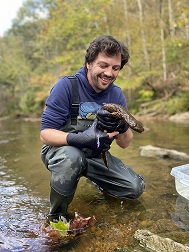filial cannibalism in hellbenders

From 2021-2023 I worked as a postdoc in Bill Hopkins’ lab investigating the population status of hellbenders in Virginia.
Using data from a long-term nest box study I documented a link between the loss of riparian forest cover and rates of filial cannibalism.
Size-structured demographic models indicate that hellbenders appear to be in extinction debt across much of their range, whereby long-lived adults persist on the landscape but the streams they inhabit no longer support sufficient recruitment for populations to persist.
This research was featured in the New York Times, Scientific American, and The Wildlife Professional.
Publications and talks
Brooks, G. C., H. K. Kindsvater, and W. A. Hopkins. A cost-benefit analysis of hellbender reintroduction strategies. in prep
Brooks, G. C., W. A. Hopkins, and H. K. Kindsvater. 2024. Concurrent threats and extinction risk in a long-lived, highly fecund vertebrate with parental care. Ecological Applications 34: e2946. link
Hopkins, W. A., B. F. Case, J. Groffen, G. C. Brooks, C. M. Bodinof Jachowski, S. T. Button, J. J. Halligan, R. S. M. O’Brien, and H. K. Kindsvater. 2023. Filial cannibalism leads to chronic nest failure of eastern hellbender salamanders. The American Naturalist 202: 92-106. link
Brooks, G. C., W. A. Hopkins, and H. K. Kindsvater. 2023. Concurrent threats jeopardize the viability of Virginia’s hellbender populations. Joint Meeting of Ichthyologists and Herpetologists, Norfolk, VA, USA.
Brooks, G. C. 2023. Assessing the Status of Virginia’s giant salamanders. Virginia Tech Postdoctoral Scholars Showcase, Blacksburg, VA, USA.

